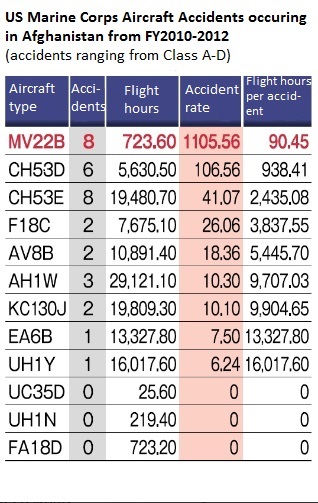Osprey accidents in Afghanistan conspicuously high at one per 90 flight hours

January 12, 2016 Ryukyu Shimpo
Sakae Toiyama reports from Washington, D.C.
Recent statistics show that during fiscal 2010-2012, the U.S. Marine Corps’ MV-22 Osprey aircraft stationed in Afghanistan experienced one Class A-D accident for every 90.4 hours of flight time. The MV-22 Osprey is a tiltrotor vertical/short takeoff and landing (VSTOL). In comparison, the average rate of accidents for all U.S. Marine Corps aircraft stationed in Afghanistan was one accident for every 3746.8 hours of flight time. This puts the Osprey’s accident rate at more than 40 times the average.
When looking at the rate of accidents per 100,000 flight hours, the average for all aircraft was 26.69 accidents, while for the Osprey it reached 1105.56 accidents. These statistics were revealed in an accident report for U.S. Marine Corps aircraft published on January 10 by the U.S. Naval Safety Center. The numbers, showing a comparatively high rate of Osprey accidents, have come to light at a time when concerns about the Osprey’s safety are already prevalent.
According to the report, Osprey flight time in Afghanistan has reached 723.6 hours. The CH-53E, another aircraft, has totaled 19,480.7 hours, while the CH-53D has reached 5630.5 hours. The Osprey is considered the Marines’ key aircraft, but its flight hours are drastically fewer than those of other aircraft.
A total of eight Class A-D Osprey accidents have occurred in Afghanistan. Of those, one was a Class A accident, the most severe type involving fatalities or a loss of $2 million or more. The other seven were Class C accidents, which involve non-fatal injuries or a loss of between $50,000 and $500,000. Losses in four of the accidents were incurred by service personnel; in two of the accidents, by maintenance problems; and in one accident, by a decrease in power. One accident was a so-called “hard landing.”
In addition to Osprey accidents, the CH-53D, a heavy-lift transport helicopter—the same that crashed into Okinawa International University in 2004—experienced one accident for every 938.4 flight hours. The CH-53E aircraft, which is also stationed at Marine Corps Air Station Futenma, experienced one accident for every 2435.0 flight hours. F-18 fighter jets experienced one accident every for 3837.5 flight hours. The rate of accidents per 100 thousand flight hours was 106.56 for the CH-53D, 41.07 for the CH-53E, and 26.06 for the F-18. Rex Rivolo, former chief analyst for the Osprey at the U.S. Institute for Defense Analyses (IDA), tells the Ryukyu Shimpo that the Osprey is a superb aircraft when operated during peacetime, but that in combat situations its utility is severely limited.
(English Translation by T&CT and Sandi Aritza)
Previous Article:“Jaws” in Okinawa Churaumi Aquarium dies after three days in captivity
Next Article:Okinawan student wins first-prize in international piano competition’s university division
[Similar Articles]
- Serious accident rates increase for Ospreys over the last year
- Air Force CV-22 Osprey involved in 30 mishaps
- Lightning strikes MV-22 Osprey belonging to US Futenma base
- CV-22 Osprey set to deploy at Yokota Air Base also being used for night training in Okinawa, has a higher accident rate than the MV-22
- Opposition to base burden increases due to Osprey training in Okinawa
 Webcam(Kokusai Street)
Webcam(Kokusai Street)


